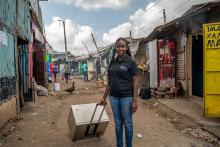
Those who are most affected by climate change today–women, girls and marginalised communities–must be involved in the design and implementation of climate response actions to ensure the equal sharing of benefits.
Explainer: Why women need to be at the heart of climate action
Because women possess unique knowledge and experience, particularly at the local level, their inclusion in decision-making processes is critical to effective climate action. A 2019 study found that increasing women’s representation in national parliaments leads to the adoption of more stringent climate change policies, resulting in lower emissions. At the local level, the participation of women in natural resource management is associated with better resource governance and conservation outcomes.
Expanding women’s access to productive resources can increase agricultural production and food security and reduce carbon dioxide emissions. If all women smallholders received equal access to productive resources, their farm yields would rise by 20 to 30 per cent, and 100 to 150 million people would no longer go hungry. Increasing farm yields can reduce the pressure to deforest more land, reducing additional emissions.
In the workplace, women’s leadership is associated with increased transparency around climate impact. Higher percentages of women on corporate boards positively correlates with the disclosure of carbon emissions information.
Effective, collective action against climate change will require big shifts in how we produce and measure economic value. Transitioning away from extractivist practices and fossil fuel economies poses an opportunity to create new jobs and reskill women workers. Increasing investment in the care sector is an effective way to shift focus towards collective wellbeing and strengthen economies without increasing emissions.
Finally, sexual and reproductive health and rights are essential for gender equality in climate action. By strengthening health systems to meet the current demand for sexual and reproductive health services, nations could safeguard recent gains made in environmental and biodiversity conservation, adaptation for change, and climate improvements in health, education and gender equality.
What does it mean to put gender equality at the centre of climate solutions?
Putting gender equality at the centre of climate change solutions means integrating diverse gender perspectives across holistic and enduring climate, environmental, and disaster risk reduction policies and programmes.
Women’s and girl’s full and equal participation in decision-making processes is a top priority in the fight against climate change. Without gender equality today, a sustainable, more equal future remains beyond our reach.
Climate solutions must also improve and invest in gender-specific statistics and data to amplify the relationship between gender and climate, strengthen and enforce land rights, and promote women-led and women-focused sustainable solutions, particularly indigenous and grassroots nature-based solutions, resource management, and food production activities.
In the páramo ecosystem of the Ecuadorian Andes, indigenous women are using sustainable agricultural production and landscape management to restore the fragile ecosystem to health after years of desertification and overgrazing, which has left large swaths of land barren and depleted. The women-led efforts are also dismantling gender stereotypes and empowering women to contribute to decision-making processes in their communities. “The páramo project shows us that without women, it’s not possible to talk about solutions to climate change and sustainable development,” says UN Women Representative in Ecuador, Bibiana Aido.
Norah Magero poses for a photo with the Vaccibox, an innovative solar-powered fridge made by her organization Drop Access using locally available materials.
Photo: RAEng/GGImages/Alissa Everett.
Finally, climate solutions must take a gender-responsive approach to financing. “Women-led actions need to be sufficiently and equitably funded to achieve a just, green transition,” says Norah Magero, a mechanical engineer and renewable energy expert from Kenya with experience in the design and management of off-grid energy technologies.
For a more sustainable tomorrow, we have to invest in and promote technologies that enhance renewable and clean energy sources and support women’s participation in their development and use. “Recognize, applaud, publish and cheer on the brave women who have constantly advocated and promoted equitable, gender-focused and just climate action measures,” Magero says.
What can you do to support climate action for women, by women?
The scope and scale of climate change impacts can be daunting, but your words and actions can affect real change in your community.
Consider supporting the work of local women-led organizations, enterprises, and cooperatives taking action against climate change. Use your voice and vote to hold leaders accountable and to press for commitments that build an equitable and enduring future.
Give power and platforms to the next generation of Earth champions by reading and sharing the stories and work of women and girls on the front lines of climate change. Use #IWD2022 to join the conversation on social media, and share how you support gender-equal climate action.
Topics
- 2030 Agenda for Sustainable Development
- Climate change